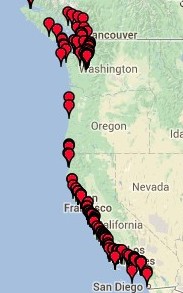NPR, Jan. 30, 2014 (Emphasis Added): […] Scientists first started noticing sick and dying sea stars last summer at a place called Starfish Point on Washington’s Olympic Peninsula. […] Reports have since surfaced from Alaska to as far south as San Diego, raising questions of whether this die-off is an indicator of a larger problem. […] fat, multi-armed stars melted into piles of mush. […] about a dozen species of sea stars are dying along the West Coast. Sea star wasting has also been reported at sites off the coast of Rhode Island and North Carolina. But researchers say until they’ve identified the cause of the West Coast die-offs, they can’t confirm any connection between these outbreaks. […] Within a few hours, the sick stars started ripping themselves apart. […] Their innards spilled out and they died within 24 hours. As for the healthy looking stars […] they didn’t show symptoms anymore rapidly by being in the same tank with sickly stars. […] Some have asked whether radiation or tsunami debris associated with the Fukushima disaster could be behind this die-off. But scientists now see Fukushima as an unlikely culprit because the die-offs are patchy, popping up in certain places like Seattle and Santa Barbara and not in others, such as coastal Oregon, where wasting has only been reported at one location. […] there’s no evidence to entirely confirm or entirely rule out […]
The Oregonian, Dec. 27, 2013: The wasting starfish found in Oregon were discovered in April […] Summer surveys along Oregon’s coast didn’t find any dying starfish, but they happened before the biggest outbreaks, [Pete Raimondi, chairman of UC Santa Cruz’s ecology and evolutionary biology department] said. A team of researchers is planning to survey Oregon’s coast again in late January. Raimondi said he doubts Oregon starfish will somehow be isolated from the outbreak.
Ben Miner, biology professor at Western Washington University, Jan. 30, 2014: “It certainly suggests that those ecosystems are not healthy […] To have diseases that can affect that many species, that widespread is, I think is just scary.”
Laura James, scuba diver, Jan. 30, 2014: “There were just bodies everywhere. There were just splats. It looked like somebody had taken a laser gun and just zapped them and they just vaporized. […] People always ask me, ‘Do you see any big difference between now and when you started? […] I’ve seen some subtle differences, but this is the change of my lifetime. We’ve had small occasional die-offs here and there — It’s not like this, a mass mortality event. ”
Ian Hewson, Cornell microbial biologist, Jan. 30, 2014: “It’s like the matrix […] We have to be very careful that we’re not identifying something that’s associated with the disease but not the cause.”
KION, Jan. 8, 2014: I asked about the starfish disease and the dead sea life off our coast. [Dan Hirsch, University of California Santa Cruz] says it’s possible fallout could be involved but unless you do the science and find Fukushima radioactive elements, don’t make conclusions.
CTV, Jan. 4, 2014 — Ed Singer, dive shop owner: “It’s troubling because it makes me wonder, what’s next?”

A new report by a physician claiming CA will suffer as much radioactive poisons as Fukushima as it keep hitting us in wave after wave, after wave……….
US media is as usual, as stupid and silent as ever. DAMN, how I hate the corporate media!
http://enenews.com/physician-its-predicted-that-in-fact-it-may-concentrate-as-much-on-the-west-coast-as-anywhere-in-fukushima-as-it-keeps-coming-wave-after-wave-video
Now, they admit radioactive water is flowing directly into the Pacific. Also, reporter shut down for trying to relate the truth. Do they think that will change anything?
http://enenews.com/nhk-broadcaster-quits-in-protest-over-nuclear-issues-professor-censored-after-20-years-on-air-was-to-reveal-extraordinarily-high-damages